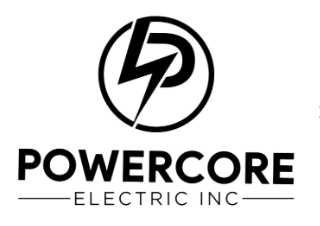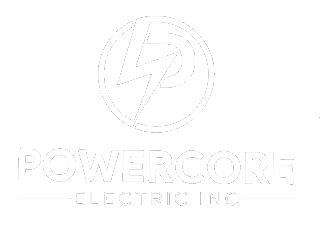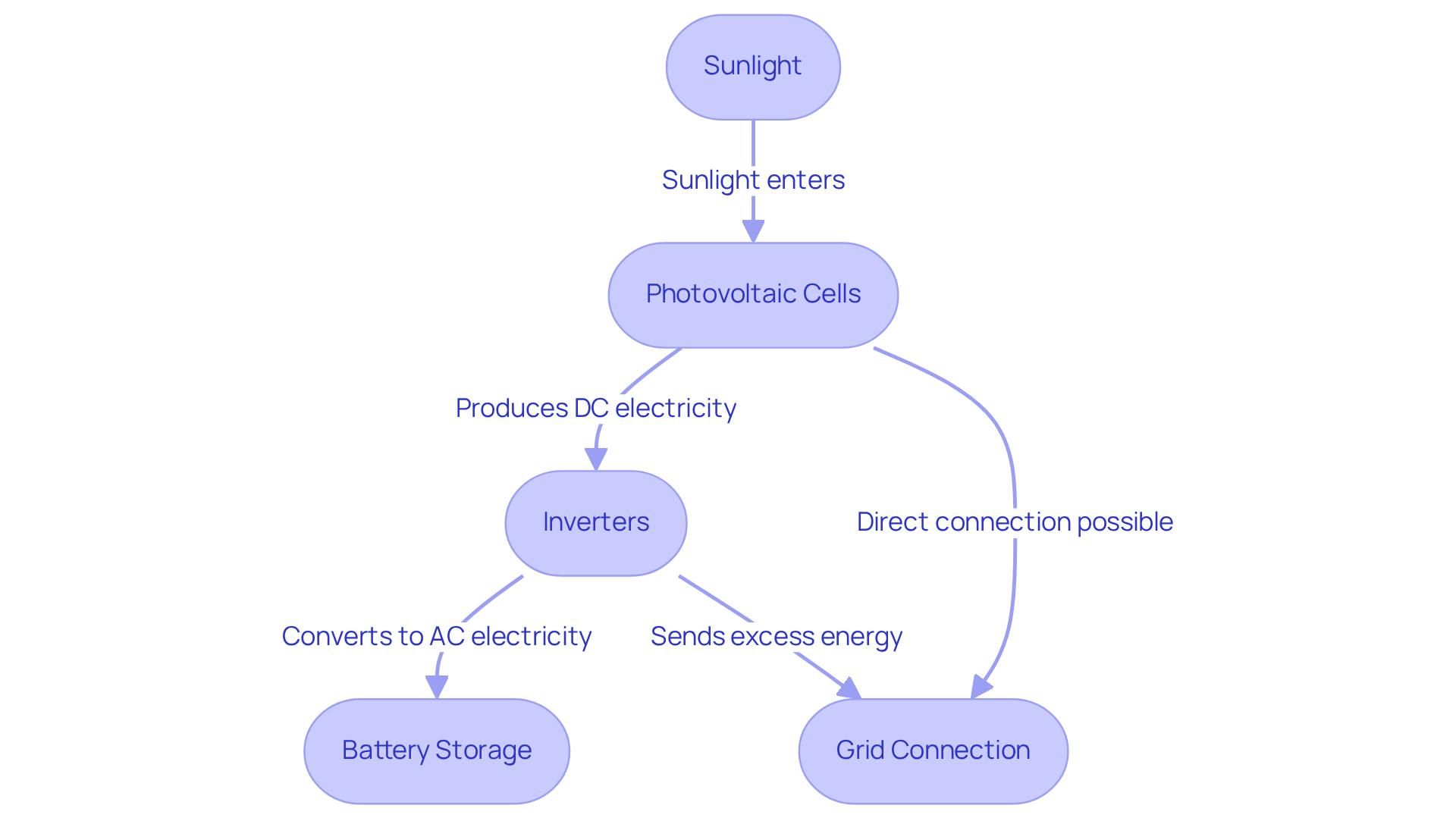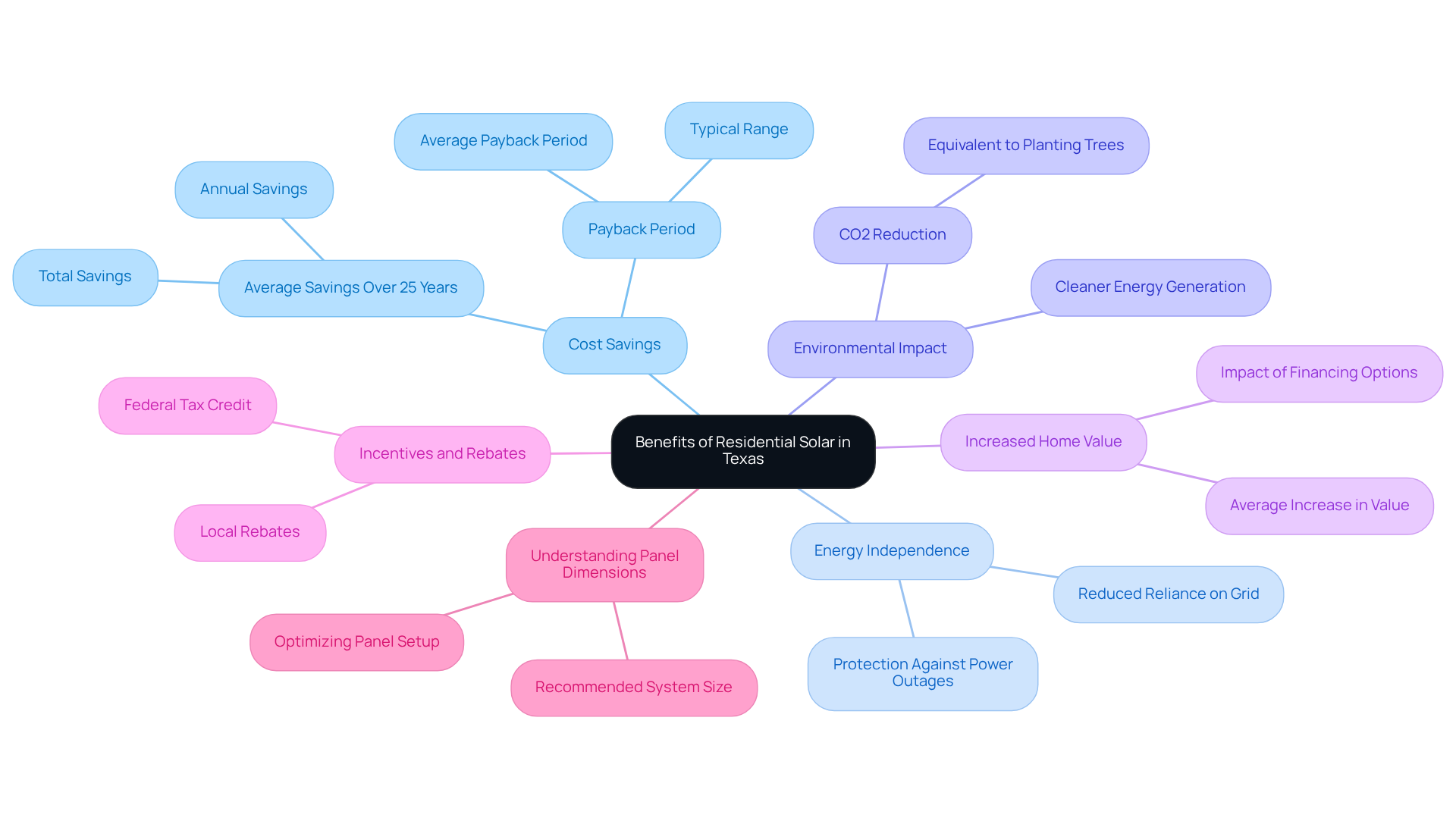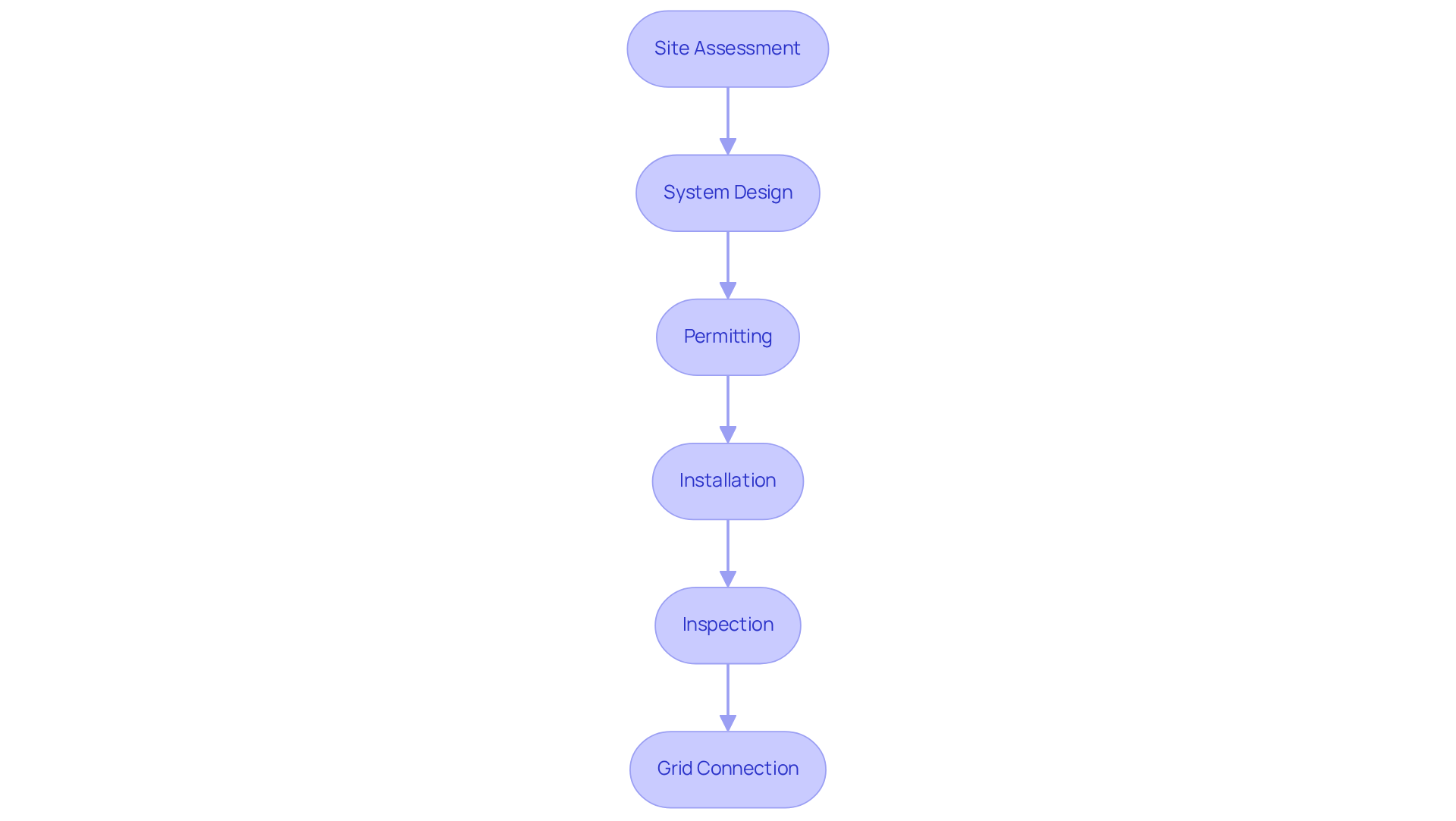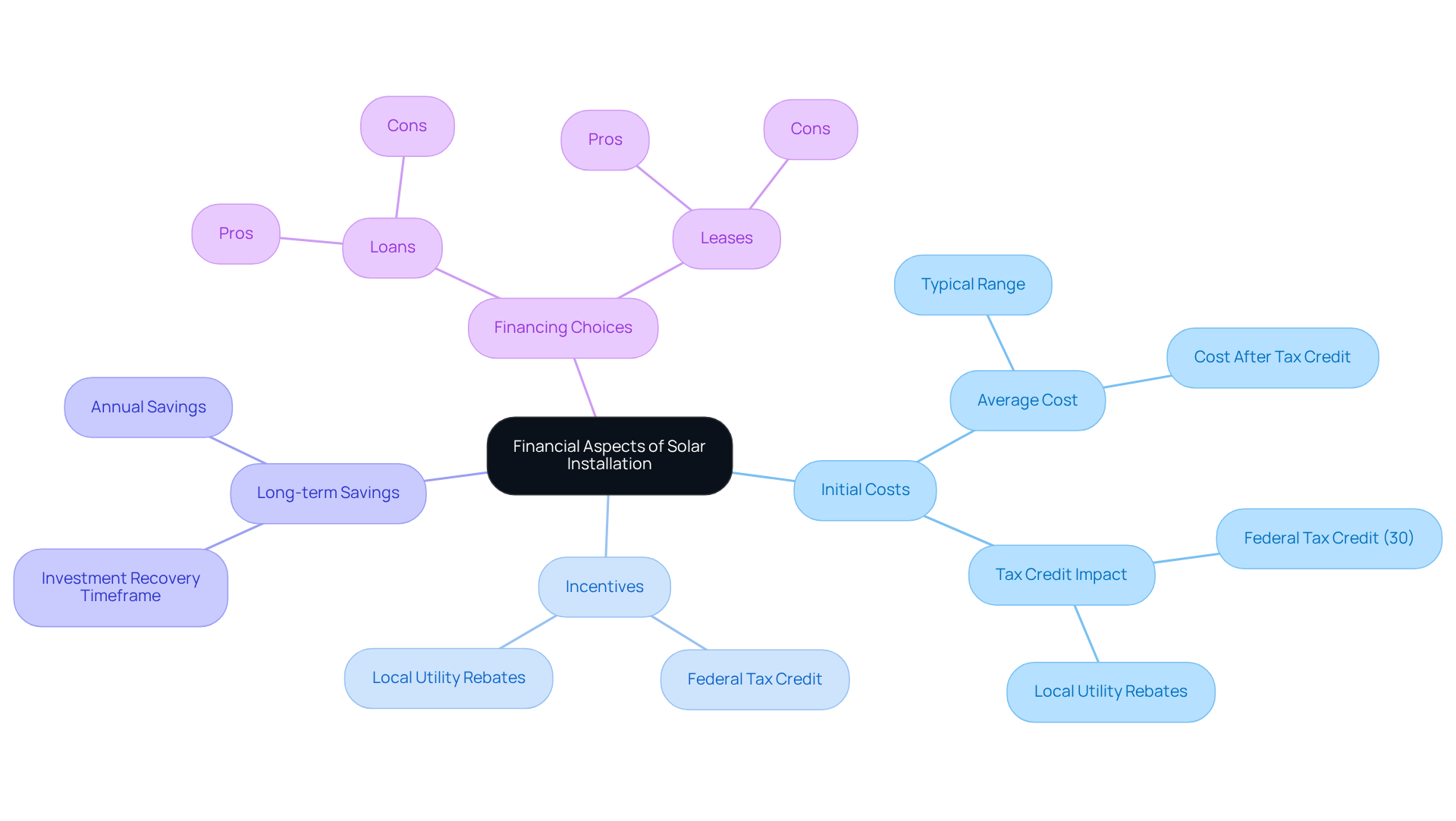Overview
The article “Master Residential Solar Texas: Benefits, Installation, and Savings” addresses the concerns many homeowners face regarding rising energy bills. It emphasizes the numerous advantages of adopting residential solar energy solutions in Texas, including:
- Significant cost savings
- Enhanced energy independence
- A positive environmental impact
By detailing the installation process and the financial incentives available, it reassures homeowners that solar energy is not only viable but also an appealing option for a sustainable future.
We understand that making the switch to solar can feel overwhelming. However, the benefits are substantial. Imagine reducing your energy costs while contributing to a cleaner environment—this is the opportunity that solar energy provides. Not only does it empower you to take control of your energy use, but it also supports a healthier planet for future generations.
The article also outlines the installation steps, ensuring that you know what to expect during the process. With various financial incentives available, now is the perfect time to explore how solar energy can transform your home and your finances. Together, we can navigate this journey toward energy independence.
If you’re interested in learning more about how solar energy can benefit you, let’s work towards a brighter, more sustainable future together. Your path to energy independence starts here.
Introduction
Rising energy bills have become a pressing concern for many homeowners. We understand that this can feel overwhelming, prompting a shift towards sustainable solutions like residential solar energy in Texas. This innovative approach not only promises significant cost savings—averaging around $79,000 over 25 years—but also enhances your energy independence and contributes to environmental sustainability.
It’s common to feel uncertain with so many options and factors to consider. How can you navigate the complexities of installation and financing to truly maximize your benefits? Together, we can explore these solutions and find the best path forward for you.
Explore the Basics of Solar Energy
Are you feeling overwhelmed by rising energy bills? You’re not alone. Many homeowners share your concerns, seeking ways to reduce costs while embracing residential solar Texas solutions. Residential solar Texas offers a nurturing path forward by harnessing sunlight through photovoltaic (PV) cells that convert sunlight into electricity. This process involves several key components:
- Photovoltaic Cells: These fundamental building blocks of solar panels are crafted from semiconductor materials that generate direct current (DC) electricity when exposed to sunlight. With typical residential setups achieving an efficiency of about 20%, high-end models can reach remarkable efficiencies of 40% to 50%. Imagine the savings!
- Inverters: These essential devices convert the DC electricity produced by the solar panels into alternating current (AC) electricity, the standard used in homes. The advancement of intelligent inverter technologies is crucial for improved grid integration and lowering total expenses, allowing you to feel more secure in your energy choices.
- Battery Storage: While not mandatory, battery setups are incredibly beneficial. They retain surplus power produced during the day for use at night or during outages, enhancing your home’s autonomy and dependability. This means you can rely on solar energy even when the sun isn’t shining.
- Grid Connection: Most residential photovoltaic setups connect to the electrical grid, allowing you to draw power when needed and sell surplus electricity back. This connection not only provides a safety net during low production times but also enhances the overall efficiency of the power network, making you a part of a larger community.
Understanding these elements empowers you to appreciate how residential solar Texas can be effectively harnessed in your home. Together, we can pave the way for a sustainable energy future. If you’re ready to explore how solar energy can transform your life, let’s work towards achieving energy independence together.
Identify the Benefits of Residential Solar in Texas
Residential solar energy systems present a multitude of advantages for homeowners in Texas, addressing common concerns about rising electricity bills:
- Cost Savings: Many homeowners find substantial relief in their electricity bills, with average savings amounting to approximately $79,000 over 25 years. This translates to about $1,500 in annual savings, making solar a financially sound investment that can ease your financial worries.
- Energy Independence: By generating their own electricity, homeowners can significantly decrease their reliance on the grid. This independence not only protects against fluctuating power costs but also strengthens resilience against power outages, especially during severe weather events that Texas often encounters.
- Environmental Impact: Solar energy systems contribute to a cleaner environment by reducing carbon emissions. A standard residential energy installation can offset 3-4 metric tons of CO2 each year, comparable to planting more than 100 trees, aligning with eco-conscious values that many of us cherish.
- Increased Home Value: Properties fitted with photovoltaic panels often see a rise in market value, averaging about 4.1% or roughly $12,141. This added value depends on how the panels are acquired or funded, making homes more attractive to prospective buyers and improving their resale potential.
- Incentives and Rebates: Texas residents benefit from various financial incentives, including a federal tax credit covering 30% of installation costs and local rebates from sources like Austin Energy and New Braunfels Utilities, which can further reduce upfront expenses. These incentives make renewable energy installations more accessible and financially appealing.
- Comprehending Residential Photovoltaic Panel Dimensions: Under the 200% guideline, property owners can optimize their renewable power advantages by grasping the suitable sizing of their photovoltaic panel setups. This understanding not only improves resource efficiency but also guarantees that property owners can fully benefit from available government programs and incentives.
To illustrate these advantages, consider the example of a property owner in Houston who set up a photovoltaic installation under the 200% guideline. By meticulously calibrating their setup, they not only lowered their utility expenses considerably but also enhanced their home’s market value, showcasing the practical benefits of renewable sources.
These compelling benefits position residential solar Texas systems as an excellent choice for homeowners aiming to improve energy efficiency and sustainability. Together, we can work towards a brighter, more sustainable future for our communities.
Navigate the Installation Process for Residential Solar
Are you feeling overwhelmed by rising energy bills? You’re not alone. Many homeowners share your concern, and it’s completely understandable. The installation process for residential solar Texas systems is designed to alleviate these worries, ensuring optimal performance and efficiency.
-
A Site Assessment is conducted. A qualified installer examines your home’s roof condition, orientation, and shading to assess its energy potential. This evaluation is essential; research indicates that proper site assessments can enhance efficiency by up to 20%. It’s common to feel uncertain about whether your home is suitable for solar, but this step provides clarity and direction.
-
Next comes System Design. After the evaluation, a tailored photovoltaic setup is created to satisfy your particular power requirements. Effective design is vital; professionals emphasize that a well-planned structure can significantly enhance energy output and longevity. Imagine the peace of mind knowing your system is designed just for you.
-
Then, we move on to Permitting. Necessary permits must be obtained from local authorities, which can vary by municipality. Understanding local regulations is crucial to avoid delays, and we’re here to guide you through this process.
-
The Installation phase is where the magic happens. The installation team mounts the solar panels, connects the inverter, and sets up any necessary components. Attention to detail is paramount during this phase, as it brings your solar vision to life.
-
After installation, a final Inspection ensures that everything meets safety and code requirements. This step is essential for guaranteeing that your system operates safely and efficiently, allowing you to enjoy your investment with confidence.
-
Finally, once approved, comes the Grid Connection. Your system is connected to the grid, enabling you to start generating electricity and reaping the benefits of your investment.
By meticulously following these steps, you can achieve a successful installation that maximizes energy production and efficiency. Together, we can pave the way for sustainable energy use. Understanding these processes is increasingly important for prospective clients interested in residential solar Texas. If you’re ready to explore how solar can transform your energy experience, let’s work towards a brighter, more sustainable future together.
Understand Financial Aspects: Costs, Incentives, and Savings
When contemplating a residential solar installation, it’s essential to understand the financial aspects that can significantly impact your decision-making process:
-
Initial Costs: We understand that the average cost of a solar panel system in Texas typically ranges from $24,000 to $36,000 before applying any incentives. However, after considering the federal renewable energy tax credit, which allows homeowners to deduct 30% of installation expenses from their federal taxes, this cost can reduce considerably, often lowering the net expense to approximately $14,115 for a standard 7.1 kW system.
-
Incentives: It’s encouraging to know that homeowners can benefit from the Federal Tax Credit for renewable energy, currently set at 30%, which can significantly reduce the initial expenses of such installations. Additionally, local utilities may provide rebates that further enhance these savings, making solar power more financially viable for you.
-
Long-term Savings: Many property owners can anticipate recovering their initial investment through energy savings within 6 to 8 years. Throughout the lifespan of the setup, which averages between 25 to 30 years, total savings can reach tens of thousands of dollars. For instance, a 6 kW photovoltaic system can save residents roughly $1,218 each year on electricity expenses, resulting in considerable long-term financial advantages.
-
Financing Choices: We recognize that different financing options are available, including loans and leases, which enable property owners to utilize renewable power without the burden of a significant initial payment. While photovoltaic loans can raise the overall expense due to accumulated interest, they offer a pathway for many to access renewable power solutions.
By understanding these financial aspects, you can better assess the viability of solar energy for your specific situation. Together, we can explore how solar energy can lead to energy independence and financial relief, making a positive impact on your life.
Conclusion
Harnessing the power of residential solar energy in Texas is not just a trend; it is a transformative step towards energy independence and financial relief. We understand that many homeowners are concerned about rising electricity bills, and by investing in solar solutions, you can significantly reduce these costs, contribute to environmental sustainability, and even enhance your property value. The journey towards adopting solar energy is paved with opportunities that empower you to take control of your energy consumption and expenses.
Throughout this article, we’ve highlighted the multifaceted benefits of residential solar systems. Imagine substantial savings over time—averaging around $79,000 over 25 years—alongside the positive environmental impact of reducing carbon emissions. These advantages are indeed compelling. While the installation process requires careful planning and execution, it is designed to ensure optimal performance and efficiency. Understanding the financial implications, including initial costs, available incentives, and long-term savings, further reinforces the practicality of making this investment.
Ultimately, embracing residential solar energy is not merely about cutting costs; it is about fostering a sustainable future and enhancing community resilience. As you consider your options, remember that investing in solar energy is a proactive choice that yields both immediate and long-lasting benefits. The time to explore the potential of solar energy is now—together, let’s embark on this journey towards a brighter, more sustainable future.
